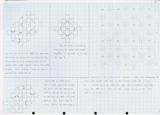Joan Taylor's Tilings
Cross and 3 key tiles
| Home |
| Eve tiling and variants |
| Rhombus seed tilings |
| Square tilings |
| Triangle and 3-fold symmetry tilings |
| Cross & 3 key tiles |
| Eve to llama tiling |
| 2 Squares tiling |
| Cube tiling |
 Cross & 3 keys tiling PDF 9.3MB |
 Cross & key tiles PDF 3.1MB |
 Cross proof 1 PDF 7.3MB |
 Cross proof 2 PDF 8.1MB |
 Cross proof 3 PDF 8.4MB |
 Cross proof 4 PDF 8.6MB |
 Cross proof 5 PDF 3.1MB |
 Addendum image PDF 3.1MB |
This tiling and those that follow are equipped with matching rules to force non-periodicity.
Cross & 3 keys tiling and Cross & key tiles. The tiles are fully described and shown also in shape-alone versions. The tiling does not have arrow markings shown but they may be inferred. A proof of aperiodicity of the prototile set is given in the remaining five images.
11th October, 2015. Some new material has been added to this topic.
Improved shape-alone matching now appears in Cross & key tiles.
Erratum
In Cross proof 5 the diagram of an inflated A tile had its blue and red stripes swapped in position. This has now been changed in the image file. The red stripe is always just clockwise of the 'out' arrow of both A and B tiles and their mirror-images. (Remember blue and red represent clockwise and anti-clockwise respectively.)
Addendum
In the interest of completeness, it would be as well to give explicit arguments against arrangements of Cross tiles not on the regular grid, which grid is assumed in the proof of aperiodicity. Robinson's tiling with its fault-lines makes an interesting comparison, his tiling also having a scale-invariant structure of square 'rings', though a different one, and 'cornered' tiles where this one has Crosses, the whole tiling being turned through pi/4 (See Grunbaum and Shephard's Tilings and Patterns, section 10.2.)
Returning to Preliminary Observations (in Cross proof 1), let a 'row' of Cross tiles be a diagonal row, as from top left to bottom right in the first diagram. Successive Cross tiles in a row enclose an A or B tile. A parallel row of Cross tiles can be placed as in the first diagram or as in the second diagram. The second has 'rows' in two orthogonal directions which we call regular grid but the first does not. The first possesses grid-slips between each row. Any such grid-slip must be infinite in length (a quick trial shows this) and has A / B tiles head to tail along the line of slip. (The exception is a possible single A or B tile orthogonal to the line of slip and connecting two semi-infinite lines of head to tail A or B tiles, which exception we can ignore.) (The arguments here apply equally to rows running from top right to botton left by symmetry.) Comparing G&S figure 10.2.2, we find there the lines of slip in the horizontal and vertical of (a) and (b) respectively and regular grid in (c).
We saw in Preliminary Observations that adjacent lines of slip is not possible. We could have shown this by considering the A / B tiles: Two adjacent parallel lines of slip (with A and B tiles head to tail along them) can have no key tile in between the lines because any key tile needs two 'in' arrown from Crosses and two 'out' arrows to the lines of A / B tiles. The situation is little changed by placing two rows of regular grid between lines of slip as in figure 1 of Addendum image. However, with three rows of regular grid between rows of slip, as in figure 2, the arrow directions all agree. But when the colours of stripes and arrows are added we have tiling failure. Figure 3 shows that no arrangement of tiles across a slip can exist, all possible arrangements of arrow directions producing tiling failure when colours of stripes and arrows are put in place. Therefore no grid-slip can occur, not even a single infinite fault-line as in Robinson's tiling, G&S figure 10.2.6, where one is shown in the vertical position. (Robinson's tiling is saved from a repetition and consequent periodicity by his asymmetric matching rules.)
We could instead propose a fault-line or multiple slips which did not disturb the regular grid of Cross tiles. (Compare Robinson's horizontal fault-line, which could have been extended indefinitely had not the vertical fault-line been there, G&S figure 10.2.6.) But we have shown that the Cross and 3 Keys regular grid tiling has a scale-invariant structure preventing such slips or even a single, infinite fault-line. This structure dictates that the sequence of arm arrow colours along any diagonal line of A / B tiles is the regular paper-folding sequence (RPFS), a scale-invariant and nonperiodic sequence. See OEIS A014577 and Cross & 3 keys tiling.
Finally, we can consider a line of Cross and C tiles as seen, with a horizontal blue stripe running through them, across the middle of Cross & 3 keys tiling. This line of Cross and C tiles could be continued indefinitely or not, as one pleases. In either case the tiling possesses structures, coordinated by the RPFS, on either side so one could not justify calling the infinite version a fault-line, merely an infinite structure. Therefore the Cross and 3 key tiles support neither periodic tilings nor any fault-lines.
